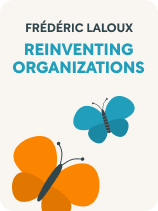

This article is an excerpt from the Shortform book guide to "Reinventing Organizations" by Frédéric Laloux. Shortform has the world's best summaries and analyses of books you should be reading.
Like this article? Sign up for a free trial here.
Does your company operate on a “need to know” basis? Does management wield all of the power?
Visionary companies eliminate the compartmentalization of information, and they distribute power. This transparency leads to trust. Employees feel respected, and performance increases.
Read on to learn more about organizational trust and transparency.
Organizational Trust and Transparency
Visionary companies’ high-minded ideals rely entirely on the trust between workers and the organization. Therefore, says Laloux, it’s imperative that organizations demonstrate their trust by allowing everyone to act responsibly without a system of controls—in particular, doing away with the compartmentalization of information. Laloux argues that total transparency is essential in building trust between an organization and its members. Trust allows workers to grow, gives them a sense of freedom, and challenges them to lead others by example.
(Shortform note: In Principles: Life and Work, Ray Dalio encourages total transparency while admitting that it can be painful in the short term. He also spells out several scenarios in which full transparency isn’t appropriate, such as when information is private or personal, or when it puts the long-term interests of the company or its clients at risk.)
Another benefit of organizational trust and transparency is that it allows every employee to see the organization from the CEO’s point of view. Keeping information on a “need to know” basis infantilizes workers by suggesting they can’t be trusted. Transparency lets employees honestly evaluate their own teams and others while increasing their sense of ownership of the company’s successes and failures. (Shortform note: In No Rules Rules, CEO Reed Hastings identifies several key areas in which transparency is especially important for building trust and accountability—financial information, any possibility of downsizing, and admitting to leadership’s mistakes. According to Hastings, this level of transparency breeds confidence and loyalty in addition to trust.)
Laloux writes that visionary companies discard the illusion that any one person can control all the needs of the group. Instead, by distributing power, they make use of the whole organization’s intelligence while forcing tough decisions on individuals and teams who otherwise would have been told what to do. While this can be intimidating, it also lets workers come up with solutions far better than those from executives unfamiliar with their day-to-day work.
(Shortform note: Increasing everyone’s sense of responsibility for the organization’s well-being can also reduce fault-finding and blame. In The Oz Principle, Roger Connors, Tom Smith, and Craig Hickman argue that in general, we need to reassess our definition of accountability by identifying how we contribute to situations. This will empower us with a sense of agency that lets us take action to address any given problem.)

———End of Preview———
Like what you just read? Read the rest of the world's best book summary and analysis of Frédéric Laloux's "Reinventing Organizations" at Shortform.
Here's what you'll find in our full Reinventing Organizations summary:
- The practices and values that are inherent in the next level of human organization
- A look at the paradigm shifts in organizational structure over the past 10,000 years
- How to implement visionary practices at your company






